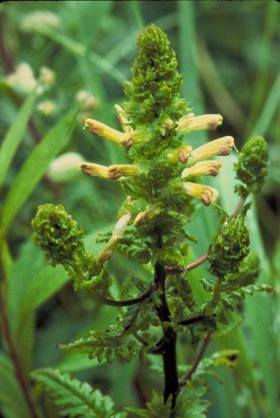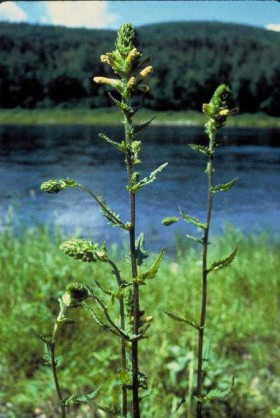(1834-1931) made her mark in history by being the first botanic artist in the “Garden of Maine.” The “Posey-Woman,” as she was called by the French Canadians in upper Maine, was determined to collect, classify, and draw all the plants of Maine. Her self-appointed life task resulted in over 4000 sheets of dried plants and ferns she discovered around the state of Maine.
Catherine “Kate” Furbish was born in Exeter, New Hampshire, on May 19, 1834. In 1835, Benjamin and Mary Lane Furbish and their first child and only daughter (Catherine) relocated to Brunswick. This town of 4,000, at that time, was alive with industry and extensive flora, which would play a big part in Kate’s future. Kate’s father owned a hardware store in Brunswick and became very active in town life – especially the schools. He built a home for his family on what is now called Cumberland Street.
Five brothers were born into the Furbish family that kept Kate’s mom very busy. Kate acquired a genteel education including painting and the study of French literature and also spent a year in Paris perfecting her painting. She developed a serious interest in science and the study of plants after attending a series of botany lectures in Boston by George L. Goodale in 1860. Growing up she had learned the names of plants while walking around Brunswick with her father and even at such a tender age, she had already developed an urge for the outdoors and what Nature had to offer.
In the spring of 1870, while still living in Brunswick with her family, Kate began to collect local plants and paint very detailed and beautiful botanical illustrations. She became a self-taught botanist who traveled throughout Maine collecting samples of flora and then classifying and drawing them. Many of her excursions took her through deep woods with swarms of black flies, or swamps of fallen, rotten trees that blocked her way. One experience nearly cost her her life as she fell through a rotten log with sharp rocks below. She managed to climb the bank and retrieve her collection basket and returned home after eleven hours.
During the 38 years from 1870-1908, Kate did the most of her collecting and painting, traveling thousands of miles alone around the state of Maine, often to untouched areas, walking, crawling, or using a raft or rowboat to reach a specimen. She relied on the Boston lectures and Asa Gray’s botany manual to confirm names and details of her finds and perfected even the tiniest details in her sketches for future painting.
Kate Furbish went through a transition period in early 1873 when both her parents died within a month of each other. She traveled around the Northeast and stayed with several relatives before returning to Brunswick in 1875. She bought a home on Lincoln Street from her brother and resolved to continue collecting and painting all the flowering plants of Maine. She lived the life of a Victorian lady who read to the elderly, kept house, dressed in a proper fashion, and attended church regularly. She spent some time in Boston furthering her skill in painting living plants.
In 1880 when Kate was on a botany trip in the untouched wilderness of Aroostook County, she came across a stand of plants with dull yellow corollas and fernlike leaves known as the common lousewort or scientifically called Pediculatis canadensis. This lousewort has never been found anywhere in the world except along a 130-mile stretch of the St. John River. In 1881, a group of botanists renamed this botanical find after its discoverer and it became known as the Furbish lousewort. This plant made headlines when after 100 years it was assumed to be extinct. In 1976, Kate Furbish became famous again when the Furbish lousewort was found again on the banks of the St. John River on land designated to be flooded in a $1.3 billion dam project. This rediscovery of the wild snapdragon helped stall and eventually stop the building of the Dickey-Lincoln dam and reservoir on the St. John River, which would have flooded 88,000 acres of northern Maine forests.
By the 1880s, Kate Furbish had earned the respect and admiration of many well-known botanists including the eminent American botanist Asa Gray. In 1894, Kate helped to found the Josselyn Botanical Society of Maine and served as its president from 1911- 1912. In 1895 the newspaper Bangor Daily Whig and Courier, reported that Miss Kate Furbish was elected as one of the vice-presidents of the Maine Botanists Society. She also lectured to several groups and published botanical articles in the American Naturalist. Kate continued her botanical work into her nineties despite having to walk with a cane.
Kate Furbish died in Brunswick on December 6, 1931, and she was buried in Pine Grove Cemetery. Her 97-year old life had come to a close, but her identity as Maine’s first botanist will live on forever. Her collection of 4,000 dried plants is housed in Harvard University’s Gray Herbarium, and her collection of 182 dried ferns was received by the Portland Society of Natural History. She had presented her “Illustrated Flora” – 16 large portfolios of watercolor drawings to Bowdoin College in her hometown of Brunswick. The Posey-Woman died doing what she loved best – looking for unusual flower and plant forms. In the end, one of these rare forms brought her a posthumous fame she had never dreamed of.
Additional resources
Coburn, Louise Helen, 1856-1949. Kate Furbish, Botanist: An Appreciation. 1924.
Graham, Ada and Frank, Jr., Kate Furbish and the Flora of Maine. Gardiner Me. Tilbury House, Publishers. 1995.
Potter, David M. Conservation Strategy for Furbish Lousewort (Pedicularis furbishiae) Habitat on the St. John River, Maine. Augusta, Me. Maine State Planning Office. 1991.
Schwarten, Lazella “Kate Furbish” in Notable American Women. Cambridge, Ma. Harvard University Press, 1971, Vol. 1, pp. 686-687.
Contributed by Laura B. Brann, Fort Collins, Colorado, 2008.



